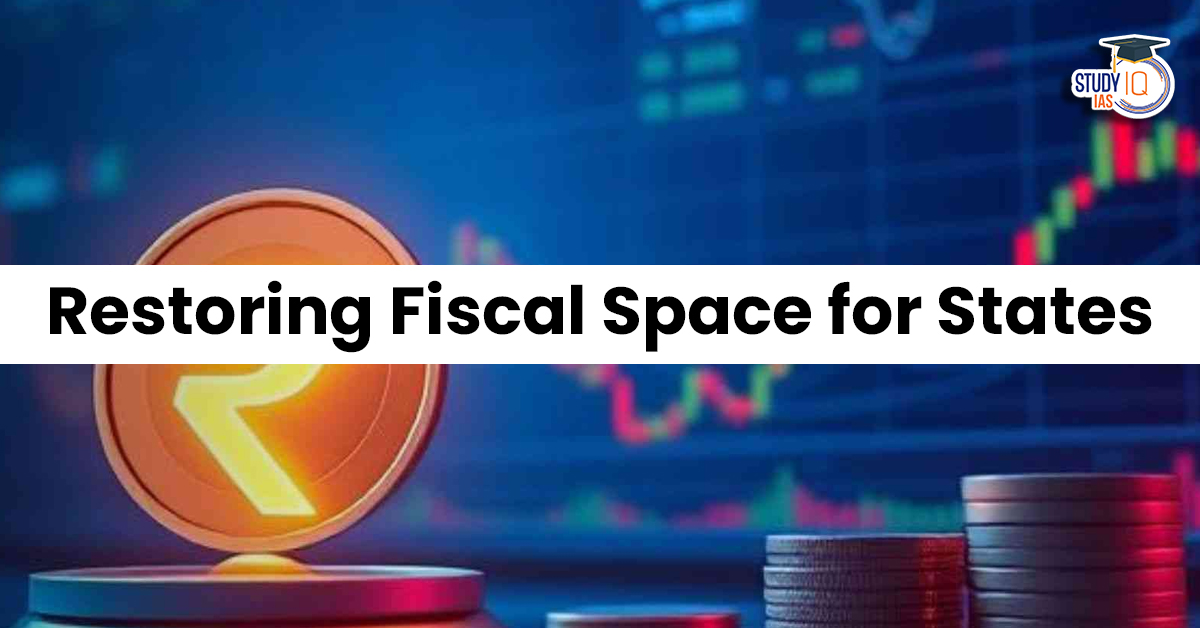Table of Contents
Context
The GST (2017) unified India’s indirect tax system but also centralised taxation powers, limiting States’ fiscal flexibility. The abolition of GST compensation cess (2025) has reignited debates over fiscal autonomy and cooperative federalism.
Background: Fiscal Federalism and the GST Transformation
Constitutional Framework
- Fiscal relations in India are guided by the Constitution, which delineates taxation and expenditure responsibilities between the Union and States:
- Articles 246 & 246A: Define legislative competence and taxation powers; the 101st Amendment introduced Article 246A to enable concurrent powers for GST.
- Articles 268-293: Lay down the framework for Centre–State financial relations.
- Article 280: Provides for the Finance Commission, which recommends principles of tax sharing and grants.
- Historically, India followed a quasi-federal fiscal model – centralising resource mobilisation for efficiency, while decentralising expenditure responsibilities to ensure accountability and service delivery.
The GST Shift
- Before GST, States independently levied taxes such as VAT, octroi, and entry tax, forming a key part of their “own tax revenue.”
- GST introduced a destination-based tax system, pooling taxation powers under the GST Council, where the Centre retains significant influence.
- Although GST increased overall tax efficiency, it diminished the States’ fiscal autonomy, as their power to vary tax rates or introduce new taxes has been severely curtailed.
Erosion of States’ Fiscal Autonomy
- Centralisation under GST:
- States lost the power to levy independent taxes like VAT and entry tax.
- The GST Council, dominated by the Centre, now decides rates and exemptions.
- End of GST Compensation:
- The 5-year compensation (2017–2022) for revenue loss has ended.
- States face uncertainty in revenue and limited flexibility in fiscal planning.
- Rise of Cesses and Surcharges:
- Cesses (e.g., infrastructure, education) are not shareable with States.
- They form nearly ₹4.23 lakh crore (BE 2025–26), reducing States’ actual tax share.
- Loss of Policy Freedom:
- States can no longer adjust tax rates for local priorities.
- Fiscal policy autonomy has been replaced by uniform centralised control.
Fiscal Dependence and Asymmetry
- Dependence on Central Transfers: On average, 44% of States’ revenue comes from the Centre.
- Eg: Bihar (72%) highly dependent; Haryana (20%) and Tamil Nadu (31%) relatively independent.
- Expenditure Burden Rising: States spend more than half of total government expenditure (≈52%) on welfare and development. Yet, their tax collection powers are shrinking.
- Unequal Treatment: High-performing States feel penalised for efficiency & Poorer States remain dependent, perpetuating fiscal imbalance.
- Political Frictions: Opposition-ruled States often allege biased fund release and policy centralisation.
| Role of the Finance Commission |
|
Key Issues in Fiscal Federalism
- Centralised Resource Control: Centre collects ~67% of taxes; States only ~33%.
- Mismatch between Resources and Responsibilities: States handle welfare and service delivery but have limited revenues.
- Falling Tax Autonomy: GST and cesses have reduced independent fiscal space.
- Limited Borrowing Freedom: Fiscal deficit limits under FRBM Acts constrain State investments.
- Unpredictable Transfers: Delayed GST payments and ad-hoc grants disrupt liquidity management.
|
Need to Restore Fiscal Space |
|
Challenges in Achieving Fiscal Space
- Centre–State Political Differences: Consensus on tax reforms is often hindered by partisanship.
- Uneven Economic Capacity: Richer States may benefit more, widening regional inequality.
- Data and Transparency Deficit: Lack of reliable fiscal data hampers evidence-based decision-making.
- Rising Debt and Deficits: High State borrowings reduce capacity for capital expenditure.
- Institutional Overlaps: Finance Commission, GST Council, and NITI Aayog often work in silos.
Way Forward
- Revisit Fiscal Devolution Formula: Ensure equitable distribution based on need, efficiency, and population equity.
- Institutional Reform: Establish a Permanent Centre–State Fiscal Council to coordinate fiscal policies, monitor transfers, and resolve disputes.
- Enhance States’ Revenue Powers: Allow limited flexibility to impose local taxes or surcharges.
- Bring All Cesses/Surcharges into Divisible Pool: Increase transparency and States’ share of national taxes.
- Strengthen Cooperative Federalism: Promote continuous fiscal dialogue and joint decision-making.
- Encourage Fiscal Responsibility and Innovation: Reward States for efficiency, fiscal prudence, and innovation in resource mobilisation.
- Adopt Data-Driven Fiscal Management: Use real-time GSTN and AI-based analytics for accurate revenue forecasting.
| Comparative Perspective: Learning from Federal Models |
|


 World Summit on Disaster Management (WSD...
World Summit on Disaster Management (WSD...
 Domestic Systemically Important Banks (D...
Domestic Systemically Important Banks (D...
 The Missing Link in India’s Critical M...
The Missing Link in India’s Critical M...

























